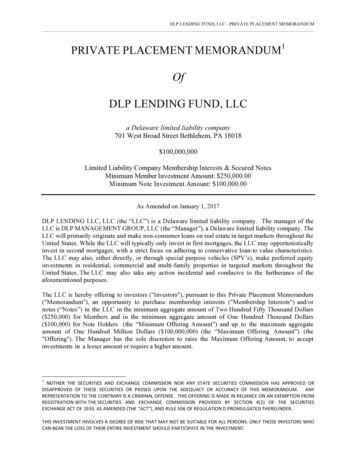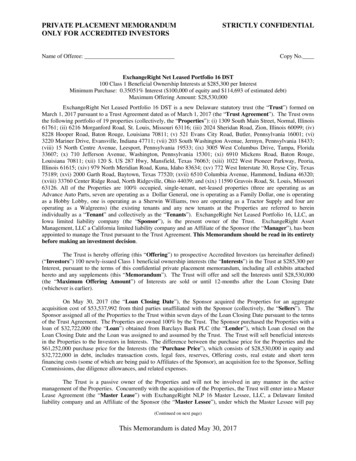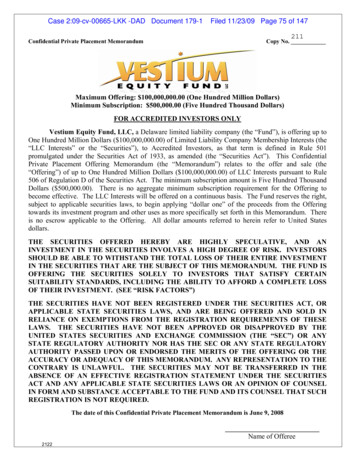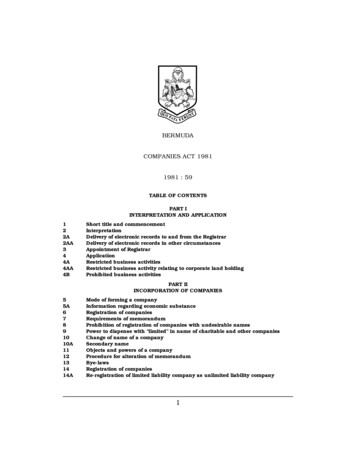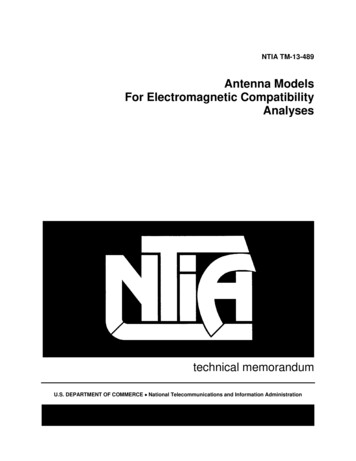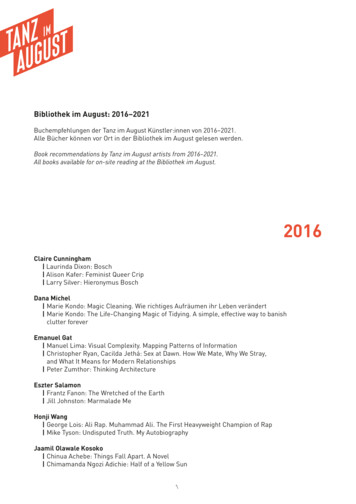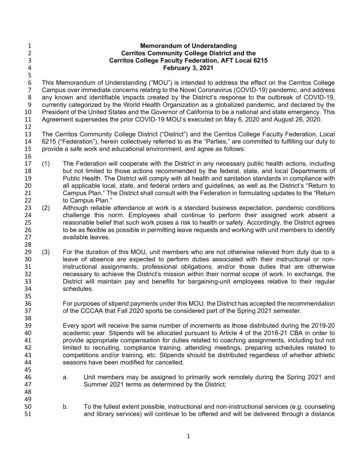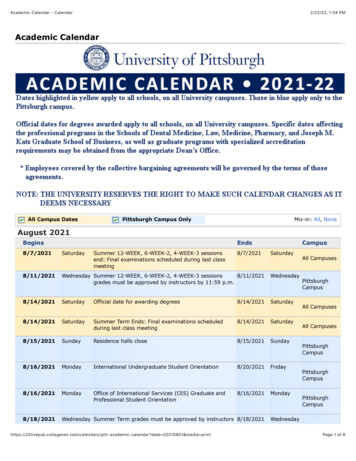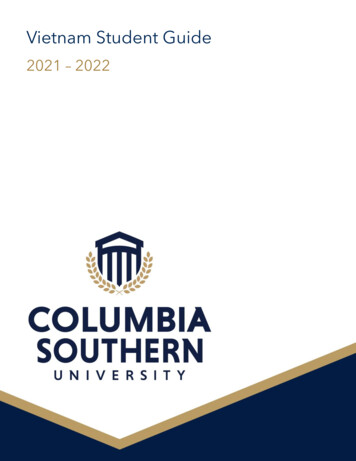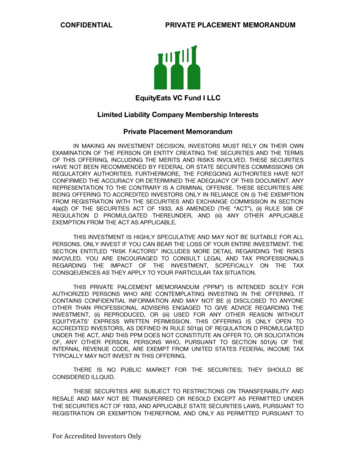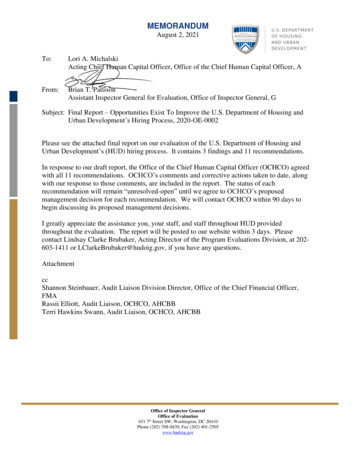
Transcription
MEMORANDUMAugust 2, 2021To:Lori A. MichalskiActing Chief Human Capital Officer, Office of the Chief Human Capital Officer, AFrom:Brian T. PattisonAssistant Inspector General for Evaluation, Office of Inspector General, GSubject: Final Report – Opportunities Exist To Improve the U.S. Department of Housing andUrban Development’s Hiring Process, 2020-OE-0002Please see the attached final report on our evaluation of the U.S. Department of Housing andUrban Development’s (HUD) hiring process. It contains 3 findings and 11 recommendations.In response to our draft report, the Office of the Chief Human Capital Officer (OCHCO) agreedwith all 11 recommendations. OCHCO’s comments and corrective actions taken to date, alongwith our response to those comments, are included in the report. The status of eachrecommendation will remain “unresolved-open” until we agree to OCHCO’s proposedmanagement decision for each recommendation. We will contact OCHCO within 90 days tobegin discussing its proposed management decisions.I greatly appreciate the assistance you, your staff, and staff throughout HUD providedthroughout the evaluation. The report will be posted to our website within 3 days. Pleasecontact Lindsay Clarke Brubaker, Acting Director of the Program Evaluations Division, at 202603-1411 or LClarkeBrubaker@hudoig.gov, if you have any questions.AttachmentccShannon Steinbauer, Audit Liaison Division Director, Office of the Chief Financial Officer,FMARassii Elliott, Audit Liaison, OCHCO, AHCBBTerri Hawkins Swann, Audit Liaison, OCHCO, AHCBBOffice of Inspector GeneralOffice of Evaluation451 7 Street SW, Washington, DC 20410Phone (202) 708-0430, Fax (202) 401-2505www.hudoig.govth
U.S. Department of Housing and Urban DevelopmentOffice of Inspector GeneralOffice of EvaluationOpportunities Exist To Improve HUD’sHiring ProcessProgram Evaluations er:Number: 2020-OE-00022020-OE-0002FebruaryAugust 2,2,20212021
Executive SummaryOpportunities Exist To Improve HUD’s Hiring ProcessReport Number: 2020-OE-0002Why We Did ThisEvaluationWe initiated this review todetermine how the U.S.Department of Housing andUrban Development (HUD)hires new employees,determine the timeliness ofthe hiring process asmeasured by the averagetime-to-hire, and determineefforts made by HUD toreduce its average time-tohire.In addition, this evaluationidentifies best practices usedby other Federal agencies.This evaluation was initiatedafter HUD’s Office ofInspector General identifiedhuman capital as a topmanagement challenge forHUD in fiscal year (FY)2020. Additionally, in its FY2018-2020 Strategic Plan,HUD identified a strategicgoal of streamliningoperations, includingimproving hiring andreducing the average time-tohire.August 2, 2021Results of EvaluationWhile some of HUD’s efforts to improve its hiring and human capitalfunctions and reduce its average time-to-hire have been successful, HUD’shiring process overall was not efficient. HUD’s Office of the Chief HumanCapital Officer (OCHCO), which is responsible for developing andimplementing policies and procedures associated with human capitalmanagement, set a goal to reduce the average time-to-hire but did not meetthis goal. OCHCO must implement efforts to improve HUD’s hiring andhuman capital functions and increase hiring efficiency, as defined in its ownhuman capital operating plans.Hiring process owners, including program office hiring managers andadministrative staff, received limited and inconsistent training on the hiringprocess and were not aware of the roles or responsibilities in the hiringprocess. The unclear roles and responsibilities, along with the inconsistenttraining, impacted HUD’s ability to hire efficiently.Additionally, OCHCO had inconsistent and unreliable hiring data due to themanual nature of the data input and the lack of interaction among the variousdata-tracking tools. As a result, OCHCO may not fully understand how wellHUD’s hiring process is operating or where its shortcomings exist. Theunreliable hiring data impede OCHCO’s and the program offices’ ability toproperly identify when to take actions for improvement.RecommendationsWe offer 11 recommendations to improve HUD’s hiring process. Six of therecommendations are aimed at process reform, and five recommendations aredesigned to support data improvement. The status of each recommendationwill remain “unresolved-open” until we agree to OCHCO’s proposedmanagement decision for each recommendation.
Table of ContentsIntroduction . 3Objectives . 3Background . 3Scope and Methodology . 8Findings. 10HUD Did Not Hire New Employees in a Timely Manner. 10HUD’s Average Time-To-Hire Did Not Meet Its Goal . 10Process Improvement Opportunities Exist To Reduce the Length of Hiring Process Steps 11OCHCO Did Not Provide Consistent Training to Hiring Process Owners or ConsistentlyDefine Roles and Responsibilities . 18High Turnover in OCHCO and BFS Resulted in Knowledge Loss and Slowed the HiringProcess. 20OCHCO Did Not Have Consistent or Reliable Hiring Metrics . 22Position Organizational Listing Was Reportedly Unreliable and Inefficient . 22Goals and Metrics Were Not Consistent, and Metrics Were Not Replicable . 23OCHCO Did Not Track the Quality of Candidates or the Number of RepostedPositions . 28Many Hiring Managers Expressed Dissatisfaction With the Quality of Candidates . 28Dissatisfaction With Candidate Quality Increased the Average Time-To-Hire . 29Recommendations . 311. Standardize Position Descriptions and Job Analyses for Mission-CriticalOccupations, High-Risk Occupations, and Positions With High-Volume Staffing Needs312. Develop and Share Best Practices With HUD’s Program Offices on How HiringManagers Can Execute Hiring Process Responsibilities To Meet Timeliness Goals . 313. Determine the Cause for the Variations in the Timeliness of the Preemploymentand Security Checks Step in FY 2017, 2018, and 2019 and Develop AppropriateProcess Improvements . 314. Develop and Document Comprehensive Reference Documents on the HiringProcesses, Procedures, Roles, and Responsibilities . 325. Develop and Implement Regular Training for Process Owners on the HiringProcess . 326. Create and Implement a Knowledge Management Strategy, Such as DevelopingStandard Operating Procedures, Reference Sheets, and Program Office Fact Sheets32
7.Conduct a Feasibility Study for an Automated POL . 328. Develop and Implement Time-to-Hire Goals That Account for Each Hiring ProcessStep. 339. Develop and Document Methodologies on How OCHCO Calculates Hiring MetricsTo Ensure That Its Hiring Metrics and Hiring Goals Align Across All of Its DataSources, Including the POL, the Human Capital Dashboard, and the HCOP . 3310. Track the Quality of Candidates as Measured by the Hiring Officials . 3311. Track the Number of Recruit Requests That Result in a Selection, the Number ofRecruit Attempts That Result in a Successful Hire, and the Number of Positions ThatAre Reposted Due to Unsuccessful First Recruit Attempts . 33Other Observations . 35Agency Comments and OIG Response . 37Appendixes . 45Appendix A – HUD’s Hiring Process Map, Created by HUD OIG . 45Appendix B – Time-To-Hire by Hiring Process Step Methodology . 49Appendix C – Selecting Comparable Federal Agencies’ Methodology . 51Appendix D – Survey Methodology and Results . 52Appendix E – Acknowledgements . 56Appendix F – Acronyms . 57List of FiguresFIGURE 1 – OPM’s hiring process roadmap . 4FIGURE 2 – FY 2017-2019 number of HUD hires . 8FIGURE 3 – HUD's FY 2019 average time-to-hire compared to goals . 10FIGURE 4 – FY 2017-2019 HUD OIG-calculated average length of each hiring processstep compared to goal. 13FIGURE 5 – Percentage of hiring manager survey respondents who correctly identifiedeach of their responsibilities . 20FIGURE 6 – Comparison of HUD’s 80-day and 98-day hiring process goals . 25FIGURE 7 – FY 2017-2019 variations in reported average time-to-hire . 26FIGURE 8 – FY 2017-2019 HUD- and HUD OIG-calculated average length of jobanalysis in days . 26FIGURE 9 – FY 2017-2019 HUD- and HUD OIG-calculated average length of time todraft the announcement in days . 27FIGURE 10 – Hiring manager survey question – You responded that you weredissatisfied with the quality of the certificates of eligible candidates you receivedfrom BFS. What issue did you have with the certificate of eligible candidates? . 29FIGURE 11 – Agency time comparison to OPM's 80-day hiring model . 51FIGURE 12 – Interpreting the Likert scale . 52FIGURE 13 – Hiring manager survey results. 53
Report number: 2020-OE-0002IntroductionObjectivesThe objectives of this evaluation were To determine how the U.S. Department of Housing and Urban Development (HUD)hires new employees.To determine whether HUD is able to hire new employees in a timely manner.To determine whether HUD’s ongoing efforts to reduce the average time-to-hire havethe intended effect.1To compare HUD’s hiring practices and timeframes to those of other similar-sizeFederal agencies.BackgroundHUD’s human capital challenges have persisted and been documented by HUD, HUD’s Officeof Inspector General (OIG), and U.S. Government Accountability Office assessments for morethan 25 years. Both HUD and OIG recognized that HUD’s inability to efficiently hire qualifiedstaff could negatively impact its ability to accomplish its mission. Therefore, HUD includedimproving hiring and human capital functions as a strategic objective in its fiscal year (FY)2018-2022 Strategic Plan, and OIG identified human capital as a top management challenge forHUD in FY 2020.U.S. Office of Personnel Management’s Hiring Initiative and ExpectationsIn FY 2017, the U.S. Office of Personnel Management (OPM) issued an End to End HiringInitiative report as part of its attempt to take a new, comprehensive, and integrated approach toFederal hiring. The initiative created roadmaps for the five components of hiring: workforceplanning, recruitment, hiring process, security and suitability, and orientation. In its hiringprocess roadmap, OPM developed an 80-day model to hire a new employee, as shown in figure1.1Average time-to-hire is the average number of days it takes to fill a vacancy.3
Report number: 2020-OE-0002FIGURE 1 – OPM’s hiring process roadmap2Source: OPM’s End to End Hiring Initiative, page 27OPM expected agencies to review the model and their internal hiring process to determine howthey could make necessary adjustments to streamline processes and improve time-to-hire. OPMpermitted agencies to modify the timeframes for each of the hiring process steps as the agenciessaw fit.3 According to OPM, the governmentwide average time-to-hire for FY 2018 was 98calendar days.4HUD’s Hiring Process RolesThe hiring process involves several process owners outside HUD and across HUD’s variousadministrative and program offices, including The Bureau of the Fiscal Service (BFS)HUD’s Office of the Chief Human Capital Officer (OCHCO)o Recruitment and Staffing Divisiono Personnel Security DivisionHUD’s Office of the Chief Financial OfficerHUD’s program officeso hiring managerso administrative officers (AO)o internal human resources offices or staffo internal budget offices or staffBFS is part of the U.S. Department of the Treasury and has provided shared services support toHUD since FY 2015. BFS is solely responsible for creating, reviewing, and posting the job2This OPM roadmap uses the acronym EOD in place of entrance on duty.On February 25, 2020, OPM issued a modification to how it collects time-to-hire data to account for the time ittakes to undergo background investigations, receive security clearances, and conduct other similar activities that areoutside the agency’s control. Specifically, OPM announced that agencies should report on a time-to-hire from boththe time the hiring manager validates the need until the candidate accepts the tentative offer and the time the hiringmanager validates the need until the entrance on duty date. This change in how time-to-hire is calculated did notimpact the scope of work for this evaluation.4These were the most recent data available at the time of fieldwork.34
Report number: 2020-OE-0002opportunity announcement for each hiring action, reviewing applications, issuing the certificateof eligible candidates, making the tentative job offer, and making the official job offer.5OCHCO is led by the Chief Human Capital Officer and is responsible for developing andimplementing policies and procedures associated with human capital management for HUD,advising the HUD Secretary and senior management on all human resources matters, and settingthe workforce development strategy for HUD. OCHCO is also responsible for calculatingHUD’s final time-to-hire and hiring metrics6 and reporting them annually to OPM. WithinOCHCO, the Recruitment and Staffing Division and Personnel Security Division play significantroles in the hiring process. The Recruitment and Staffing Division advises and provides hiringstrategies and resources to HUD’s program offices and is comprised of human resourcesbusiness advisors and human resources business partners. The Personnel Security Divisionconducts the security process portion of hiring for HUD. While OCHCO and BFS consultregularly on hiring actions, HUD has final authority on hiring decisions.The Office of the Chief Financial Officer is responsible for reviewing and approving hiringrequests to determine whether the program office can afford to hire based on its staffing levelsand budget. It also does biweekly payroll projections to determine what hiring has occurred,what hires are planned, and the program offices’ funding statuses through yearend.Employees in HUD’s program offices that have a role in the hiring process are the hiringmanagers, the AOs or administrative staff, the internal human resources staff, and the internalbudget staff.7 The hiring manager is solely responsible for validating a need to hire, requesting apersonnel action to initiate the hiring process, reviewing applicants, conductinginterviews, and making a selection. It is the responsibility of both the manager and BFSto collaborate and review the position description, confirm the job analysis, receiveapplications, conduct preemployment and security checks, and finalize entrance on dutydates.8,9While the AO role in the hiring process is not uniform, the AOs are key players in thehiring process and considered the hiring point of contact in the program office. The AOoften serves as an intermediary between BFS and the hiring manager and OCHCO and5A certificate of eligible candidates is a listing that contains the highest ranked eligibles, after application ofveterans’ preference, and a result of public notice, recruitment, and screening and assessment efforts. The list isprepared and issued by BFS and is the list from which the hiring manager will select a candidate.6Throughout this report, metric is used when referring to actual performance numbers that OCHCO calculates, suchas the average time-to-hire.7Unlike human resources specialists in OCHCO, HUD program offices’ internal human resources staff is not part ofjob series 201 – Human Resources Management.8A position description is a statement of the major duties, responsibilities, and supervisory relationships of aposition. In its simplest form, a position description indicates the work to be performed by the position. Thepurpose of a position description is to document the major duties and responsibilities of a position, not to spell out indetail every possible activity during the workday.9A job analysis identifies the competencies and knowledge, skills, and abilities directly related to performance onthe job. It is a systematic procedure for gathering, documenting, and analyzing information about the content,context, and requirements of the job. It demonstrates that there is a clear relationship between the tasks performedon the job and the competencies and knowledge, skills, and abilities required to perform the tasks.5
Report number: 2020-OE-0002 the hiring manager. Often, the AO puts the hiring package together on behalf of thehiring manager.Some HUD program offices have their own internal human resources staff. However,these employees are not human resources specialists, and all HUD hiring must go throughBFS and OCHCO.The program office has internal budget staff responsible for ensuring that the office doesnot exceed its budget allotment. Some program offices require their budget offices toreview hiring requests. Others require a second budget approval10 from an internalbudget officer before an official job offer is made to ensure that funding is still available.Distinction Between Step Zero and the Hiring ProcessA critical part of the success of the hiring process begins before a hiring manger starts therecruiting process, commonly referred to as “step zero.”11 Step zero includes the time duringwhich the hiring manager, OCHCO, and BFS work together to create the position descriptionand the job analysis, as well as the time it takes BFS to classify the position. The classifiedposition description and job analysis, as part of a hiring package, must be submitted by aprogram office to OCHCO to start the hiring process. Therefore, the time it takes to write andclassify a position description and write a job analysis is not included in the calculated averagetime-to-hire. One BFS official estimated that the position description and job analysis couldeach take between 30 and 60 days.According to BFS’s Hiring Process Job Aid, HUD’s hiring process has 13 steps. These aredescribed in brief below and shown in detail in a process map in appendix A.1. Validate need – The HUD program office hiring manager determines that a vacancyneeds to be filled and obtains internal program office approval as needed.2. Request personnel action – The program office then puts together a hiring package andprepares an official hiring request in the human resources system so OCHCO and BFScan review and approve it.3. Review position description – BFS must review and validate the position description.4. Confirm job analysis – BFS must review and approve the job analysis.5. Post job opportunity announcement – BFS creates and posts the job announcement onUSAjobs.gov.6. Receive applications – BFS receives applications.7. Minimum qualification review – Once applications are received, BFS does a minimumqualification review, which is the rating and ranking of candidates.8. Issue certificate and notify applicants – BFS prepares a certificate of eligible candidatesand submits it to the HUD program office hiring manager. BFS also notifies applicantsof the status of their applications.10The Office of the Chief Financial Officer conducts the initial budget approval process before the recruitmentprocess can begin.11A hiring manager does not need to be actively looking to fill a vacancy to engage in step zero of the hiringprocess.6
Report number: 2020-OE-00029. Interview and select – The hiring manager uses the certificate to determine whichcandidates to interview to select a candidate to hire. The hiring manager informs BFS ofthe decision.10. Tentative job offer – BFS makes the tentative job offer to the selected candidate(s).11. Preemployment and security checks – OCHCO’s Personnel Security Division does thepreemployment and security checks on the candidate and alerts BFS of its securityprocess approval.12. Official job offer – BFS makes the official job offer to the selected candidate(s).13. Entrance on duty12 – The candidate then accepts the official job offer and agrees to a startdate.HUD’s Commitment To Improve Its Hiring ProcessHUD has committed to improve its hiring process and reduce its average time-to-hire. In the FY2018-2022 Strategic Plan, strategic objective 11 is to “[o]rganize and deliver services moreeffectively.” As part of this objective, HUD committed to improving the hiring process byidentifying bottlenecks and needed resources to reduce the average time-to-hire. One of thestrategies HUD proposed to help achieve this objective was to “[i]mprove the hiring and humancapital functions, to reduce average time-to-hire and improve the quality of hires, to ensure HUDattracts, trains, and retains an efficient workforce with an accountability structure thataccomplishes [HUD’s] mission.” To measure progress toward its objective, HUD usedperformance indicators, including tracking its average time-to-hire.OCHCO has led many of HUD’s efforts to improve hiring and human capital functions.OCHCO restated HUD’s commitment to improving the hiring process and reducing its time-tohire in both its FY 2018-2019 and FY 2020-2021 Human Capital Operating Plans (HCOP). Inthe FY 2018-2019 HCOP, OCHCO identified five actions that it would take.1.2.3.4.Reduce the average time-to-hire.Increase the quality of hires as measured by the hiring official.Increase the sources of hires through external hiring.Increase the use of data analytics to demonstrate historical hiring trends and developstrategies to improve time-to-hire and support sound position management andorganizational design.5. Strengthen strategic partnership between OCHCO and the HUD workforce.In FY 2019, OCHCO’s efforts to increase hiring resulted in an increase in employees for the firsttime since 2011. HUD hired more external new employees than the total number of employeeswho separated from HUD in FY 2019. HUD also hired significantly more employees in FY2019 than it had in FY 2017 or FY 2018, as shown in figure 2.12Entrance on duty is the process by which a person completes the necessary paperwork and is sworn in as anemployee. The entrance on duty date is typically the new employee’s first day.7
Report number: 2020-OE-0002FIGURE 2 – FY 2017-2019 number of HUD hiresNumber of Hires1070943870681649FY 2017FY 201867047027070FY 2019Source: HUD time-to-hire reports provided by BFSScope and MethodologyWe completed this evaluation under the authority of the Inspector General Act of 1978, asamended, and in accordance with the Quality Standards for Inspection and Evaluation issued bythe Council of the Inspectors General on Integrity and Efficiency (January 2012).ScopeWe performed fieldwork for this evaluation between February and November 2020. Ourevaluation focused on HUD’s hiring process, which begins with validating the need to hire andends with the entrance on duty date of the new employee. In our analysis of hiring data, we used3 years of the most recently available data at the time of our fieldwork: FY 2017 through FY2019.MethodologyTo address our objectives, we reviewed relevant HUD policies, publications, and otherdocumentation. We reviewed hiring data, metrics, and milestones, including average time-tohire, from FY 2017 through FY 2019, as provided by HUD and HUD’s shared service provider,BFS. Most of our analysis focused on the 13 steps of the hiring process. However, we includedstep zero in our analysis when it related to the actions OCHCO committed to as part of its effortsto reduce average time-to-hire.We conducted 46 interviews with officials from HUD, BFS, the U.S. General ServicesAdministration (GSA), and the U.S. Small Business Administration (SBA). The staff memberswe selected for interview from each agency were the ones considered subject-matter experts wellpositioned to speak about the hiring process. We also conducted a survey of all HUD hiringmanagers, referred to in this report as the hiring manager survey, to gather program officeperspectives on the hiring process. Finally, we contacted OPM to obtain input on OPM’sexpectations of Federal agencies regarding the hiring process.8
Report number: 2020-OE-0002See appendix B for detailed methodology on our analysis of the average time-to-hire by hiringprocess step, appendix C for detailed methodology on how we chose GSA and SBA as agenciescomparable to HUD, and appendix D for detailed methodology on our hiring manager surveyand the results.LimitationsHiring manager survey results were self-reported by HUD hiring managers, and we did notvalidate the results for accuracy. Because survey responses were voluntary, there is a potentialfor voluntary response bias. Therefore, the resulting responses could tend to overrepresent thoseindividuals who have strong opinions. As described in appendix D, 227 of 377 possible hiringmanager survey recipients responded, resulting in a 60.2 percent response rate. We did not usesurvey results to make any projections or assumptions about the universe of hiring managers.We were unable to replicate and validate all hiring metrics. We describe these data limitations ingreater detail in the Findings section of this report.Information that GSA and SBA provided to us was used only to gain insight into Federalagencies that have attributes similar to those of HUD. We did not attempt to independentlyvalidate any information provided to us by GSA or SBA, nor are we evaluating or makingconclusions on GSA’s or SBA’s processes.9
Report number: 2020-OE-0002FindingsHUD Did Not Hire New Employees in a Timely MannerAccording to our calculations, the HUD FY 2019 average time-to-hire was 141 days, whileHUD’s reported goal was 108 days.13 There are three primary reasons why HUD was unable tohire staff in a timely manner. Foremost, OCHCO did not implement process improvements toreduce the length of four hiring process steps that took longer than they should have; namely,review position description, confirm job analysis, interview and select, and preemployment andsecurity checks. Secondly, HUD employees reported inconsistent training on the hiring processand unclear hiring roles and responsibilities. Finally, OCHCO and BFS both experienced highturnover.During fieldwork, we attempted to validate different metrics that HUD reported, but we wereunable to replicate the data. Therefore, throughout the report, we present the metrics that wecalculated, unless otherwise noted. For more information on the average time-to-hire, see thesection OCHCO Could Not Provide a Replicable Methodology of Average Time-To-Hire.HUD’s Average Time-To-Hire Did Not Meet Its GoalIn FY 2019, HUD exceeded OPM’s average time-to-hire goal by 61 days and HUD’s averagetime-to-hire goal by 33 days. We calculated HUD’s FY 2019 average time-to-hire as 141 days,while OPM’s goal was 80 days and HUD’s goal was 108 days14 (figure 3). Further, only 29.3percent of hires made it through the hiring process within 108 days, and 11.6 percent of hiresmade it through within OPM’s 80-day model.FIGURE 3 – HUD's FY 2019 average time-to-hire compared to goalsHUD OIG-calculated actual time-to-hire141HUD goal108OPM goal80020406080100120140160DaysWe calculated HUD’s actual average time-to-hire for FY 2019 using data provided by BFSbecause OCHCO was unable to provide a replicable methodology on how it calculated time-tohire. OCHCO also reported different average time-to-hire calculations for FY 2019 in variousdocuments and publications, complicating our attempts to replicate O
HUD's hiring process is operating or where its shortcomings exist. The unreliable hiring data impede OCHCO's and the program offices' ability to properly identify when to take actions for improvement. Recommendations We offer 11 recommendations to improve HUD's hiring process. Six of the

